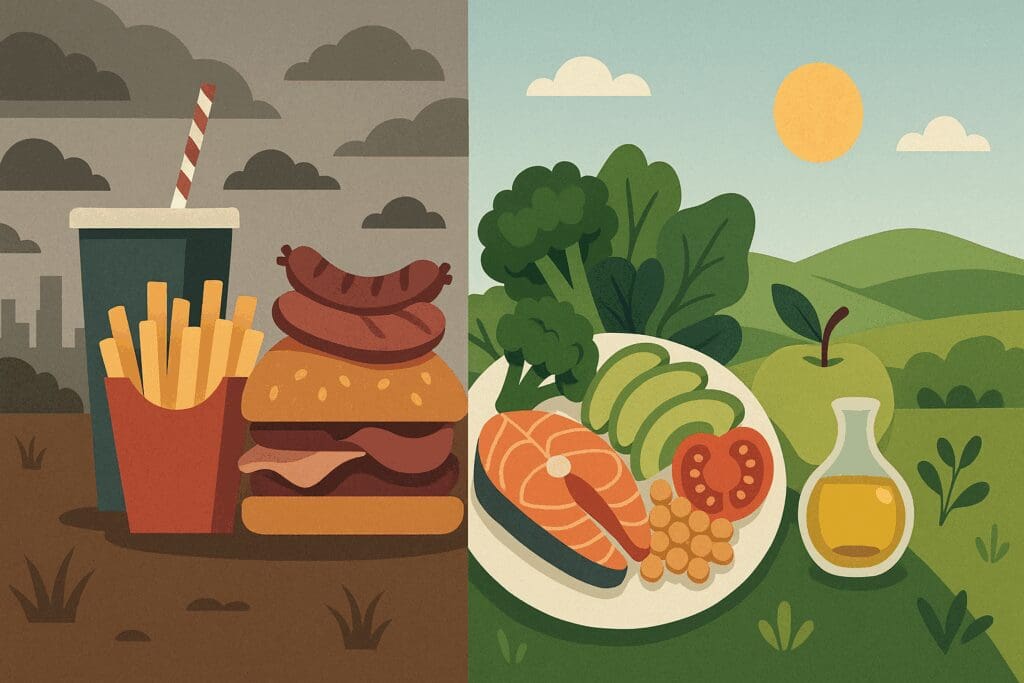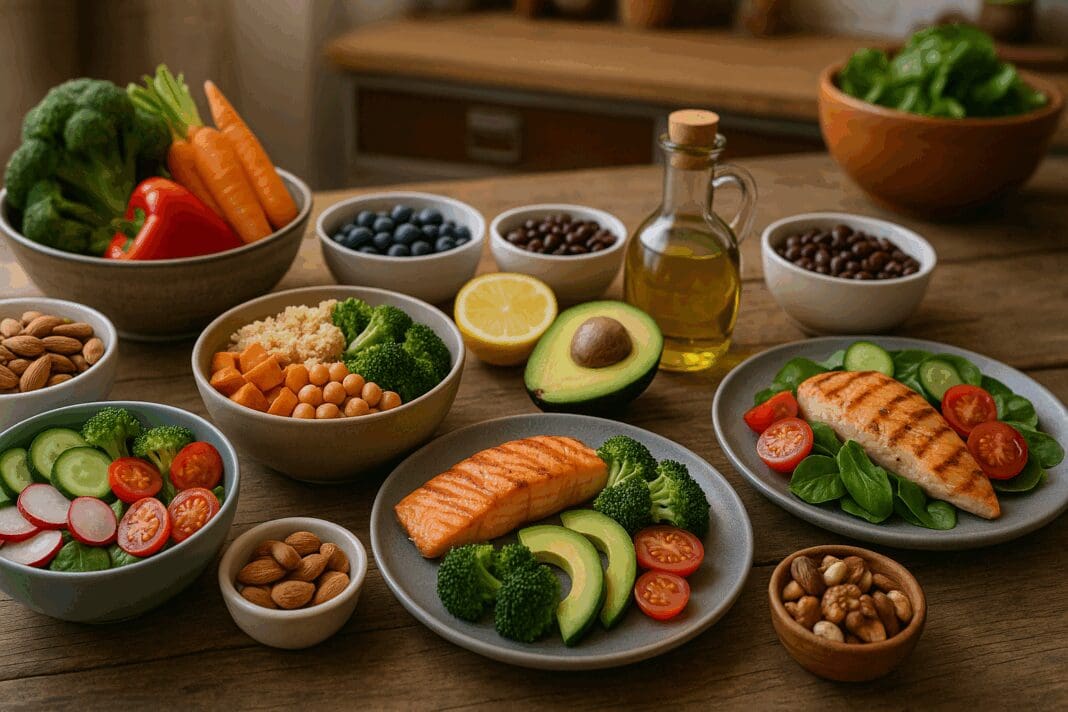Introduction: Understanding the Power of Balanced Nutrition for Lifelong Wellness
At the heart of every healthy lifestyle lies a foundational principle that is often misunderstood or overlooked: balanced nutrition. In a society increasingly dominated by ultra-processed foods, quick-fix diets, and conflicting dietary advice, many individuals struggle to make informed choices that support both immediate vitality and long-term health. The concept of balanced nutrition, however, offers a science-backed framework for creating sustainable eating patterns that nourish the body, support cognitive function, reduce disease risk, and foster overall well-being. Far from being a rigid set of rules, balanced nutrition is an adaptable and empowering approach to food—one that respects bioindividuality, cultural diversity, and changing life stages.
Balanced nutrition is not simply about portion control or eating from every food group. It embodies the idea that our meals should provide the right amount of energy and nutrients in harmony with our body’s needs, preferences, and activities. It is about learning how macronutrients and micronutrients work in synergy, and how each contributes to physical and mental health. With the right knowledge and habits, individuals can break free from the cycle of yo-yo dieting and develop a personalized eating strategy rooted in both science and self-awareness. This guide dives deep into the components, benefits, and strategies for achieving balanced nutrition, while also integrating the latest American nutrition guidelines, global food research, and real-world applications that foster healthier habits that last.
By exploring key concepts such as nutrient density, food variety, mindful eating, and meal planning, this article equips readers with the tools needed to evaluate what is in the food they consume and make smarter decisions. Whether you are just beginning your wellness journey or looking to refine an already healthy lifestyle, understanding balanced nutrition is a powerful step toward building a resilient and nourished body for life.
You may also like: 10 Essential Nutrition Rules to Follow for a Healthy Diet for Women in 20s

Defining Balanced Nutrition in a Modern Context
Balanced nutrition is more than just a trending phrase—it is a scientifically grounded approach to dietary intake that focuses on providing the body with optimal proportions of essential nutrients. These nutrients include macronutrients such as carbohydrates, proteins, and fats, as well as micronutrients like vitamins and minerals. The goal of balanced nutrition is to maintain metabolic harmony, ensure tissue repair, support immunity, and sustain energy levels throughout the day. Unlike extreme or elimination diets that may emphasize one food group at the expense of another, balanced nutrition promotes a holistic view of food as an integrated support system for life.
The dietary guidelines definition food experts often rely on involves a comprehensive understanding of how each nutrient plays a role in bodily function. Carbohydrates provide a primary energy source for brain and muscle activity, but the type of carbohydrate—complex versus simple—can drastically influence blood sugar regulation. Proteins, composed of amino acids, are critical for building muscle, repairing cells, and synthesizing hormones and enzymes. Healthy fats, including monounsaturated and polyunsaturated fats, contribute to cell membrane structure, hormonal health, and inflammation reduction.
To practice balanced nutrition, one must also consider the synergy between these nutrients and how they appear in whole, minimally processed foods. For example, a salad with mixed greens, grilled chicken, olive oil dressing, and a side of quinoa contains all three macronutrients in natural form, along with fiber and antioxidants. In contrast, highly processed packaged meals, while convenient, often contain imbalanced ratios of sugar, fat, and sodium with limited nutritional value. Recognizing the nutritional profile of everyday foods and striving for nutrient-dense, colorful meals is central to building a sustainable foundation of healthy balanced meals.

The Evolution of U.S. Dietary Recommendations and Their Role in Balanced Nutrition
The American diet has undergone significant transformation over the past century, reflecting shifts in agricultural practices, economic growth, globalization, and public health awareness. As chronic diseases like heart disease, obesity, and type 2 diabetes began to rise in the mid-20th century, policymakers and health professionals recognized the need for clear, evidence-based nutrition advice. This gave rise to a series of evolving US dietary recommendations, including the famous food pyramid and, more recently, MyPlate—a visual model designed to help Americans compose balanced meals.
The transition from generalized guidelines to personalized dietary tools reflects a growing recognition of bioindividuality and lifestyle diversity. Today’s nutrition and diet guidelines emphasize a variety of whole foods, plant-forward meals, and the reduction of added sugars, refined grains, and saturated fats. Importantly, the most recent Dietary Guidelines for Americans encourage a lifelong approach to nutrition—beginning in infancy and continuing through older adulthood. This longitudinal perspective helps individuals understand how their nutritional needs shift with age, activity level, and health status.
Despite these efforts, a significant gap remains between recommendations and real-world behavior. According to recent studies, the average American diet remains heavily reliant on processed foods high in sodium and low in fiber, with insufficient consumption of fruits, vegetables, and whole grains. Bridging this gap requires not only public education but also systemic changes in food access, marketing, and affordability. Still, for individuals and families, adopting the principles of balanced nutrition based on the nutrition guide provided by the USDA and other reputable sources can dramatically improve dietary quality. Understanding the intent behind national guidelines makes it easier to evaluate nutrition information critically and apply it practically in everyday life.

How to Interpret Nutrition Info on Labels and Menus
In today’s food marketplace, consumers are faced with an overwhelming array of choices, many of which are accompanied by marketing claims that can obscure the true nutritional value of a product. Learning how to interpret nutrition info—particularly on food labels and restaurant menus—is a vital skill in the pursuit of balanced nutrition. It allows individuals to make informed decisions, avoid misleading claims, and align their choices with their health goals.
The Nutrition Facts panel, required on most packaged foods in the United States, provides a snapshot of a product’s caloric content and the amounts of key nutrients per serving. To apply this information effectively, one must first understand serving size—often the most misunderstood aspect of a label. A bag of chips, for example, may appear moderate in calories at first glance, but if the serving size is a third of the package, total intake can easily triple.
Key elements to examine include the amounts of added sugars, dietary fiber, saturated and trans fats, and sodium. Ideally, a product should be low in added sugars and saturated fats, moderate in sodium, and high in fiber, vitamins, and minerals. Percent Daily Values (%DV) provide a useful benchmark, indicating whether a product is a low or high source of a particular nutrient. Generally, 5% or less of a nutrient per serving is considered low, while 20% or more is considered high.
When dining out, understanding what is in the food on menus is equally critical. Many restaurants now offer calorie counts, and some even provide full nutrition information online. However, calories alone do not reflect nutrient density. A 500-calorie meal of fried food lacks the beneficial nutrients present in a 500-calorie bowl of lentil soup, whole grain bread, and a spinach salad with vinaigrette. Making mindful menu selections, asking for dressings on the side, or substituting fried sides for steamed vegetables are practical steps that reflect the principles of balanced nutrition in action.
Building Healthy Balanced Meals at Home
Perhaps the most powerful way to take control of your health is to prepare meals at home using fresh, whole ingredients. Creating healthy balanced meals does not require culinary expertise or gourmet ingredients. Instead, it requires understanding a few core principles and applying them consistently. A well-balanced plate typically includes a source of lean protein, a complex carbohydrate, healthy fat, and a generous portion of vegetables or fruits, ideally with a variety of colors and textures.
Proteins can come from animal or plant sources, such as eggs, chicken, tofu, lentils, or Greek yogurt. Whole grains like brown rice, quinoa, or farro offer fiber and sustained energy, while healthy fats from avocados, nuts, seeds, or olive oil contribute flavor and satiety. Vegetables and fruits provide a range of phytonutrients, antioxidants, and water-soluble vitamins necessary for immune function, skin health, and metabolism.
Batch cooking and meal prepping are effective strategies for maintaining consistent access to nutritious meals throughout the week. Preparing large quantities of staples—like roasted vegetables, grilled chicken breasts, or cooked grains—can save time and reduce reliance on convenience foods. Building a grocery list around whole foods, reading labels carefully, and avoiding the temptation of ultra-processed snacks all support the formation of sustainable habits.
To promote balanced nutrition, meals should also be spaced throughout the day in a way that supports stable blood sugar levels and metabolic function. Skipping meals or consuming large, irregular portions can disrupt the body’s internal rhythms, contributing to fatigue, cravings, or overeating later on. Incorporating regular meals and snacks that combine protein, fiber, and healthy fat—such as apple slices with almond butter or hummus with carrots—can promote sustained energy and cognitive clarity.

Balanced Nutrition Across the Lifespan: Adapting to Age and Stage
One of the most dynamic aspects of balanced nutrition is its adaptability across the lifespan. Nutritional needs are not fixed; they evolve with age, life circumstances, and health conditions. A child’s requirements for growth and cognitive development differ greatly from an older adult’s need to preserve bone mass and muscle strength. To sustain health over decades, it is essential to understand how balanced nutrition manifests in different stages of life and to adjust dietary strategies accordingly.
During infancy and early childhood, nutrition supports rapid physical and neurological development. Breast milk or formula provides the foundation, followed by the gradual introduction of solid foods rich in iron, healthy fats, and essential vitamins. As children grow, a diverse diet that includes whole grains, lean proteins, dairy or fortified alternatives, fruits, and vegetables supports immune development, cognitive function, and physical growth. Encouraging healthy food preferences early in life sets the stage for better choices in adolescence and adulthood.
Teenagers experience hormonal shifts, growth spurts, and increased caloric demands, particularly for those who are active in sports. Balanced nutrition at this stage must prioritize calcium for bone growth, iron for oxygen transport, and protein for muscle development. Unfortunately, adolescence is also a time when poor dietary patterns often emerge, including high consumption of sugary drinks, fast food, and ultra-processed snacks. Supporting teens with nutrition guide resources and practical cooking skills can empower them to take ownership of their health.
In adulthood, balanced nutrition focuses on maintaining metabolic efficiency, managing stress, and supporting fertility in some cases. With longer workdays and responsibilities, meal planning and prioritizing nutrient-dense options become increasingly important. As individuals reach their senior years, nutritional concerns may shift to include increased needs for vitamin B12, vitamin D, and calcium, along with strategies to prevent sarcopenia and cognitive decline. At every age, the application of nutrition and diet guidelines helps maintain optimal health, resilience, and quality of life.

Chronic Disease Prevention and Management Through Balanced Nutrition
An abundance of scientific research now confirms what many cultures have known for centuries: food is medicine. Balanced nutrition plays a central role in preventing and managing chronic diseases, which are now the leading causes of death and disability worldwide. Conditions such as type 2 diabetes, cardiovascular disease, hypertension, obesity, and certain cancers are all closely linked to dietary patterns. A well-planned diet rich in whole foods and low in inflammatory components offers one of the most powerful tools for long-term health protection.
For example, high intake of refined carbohydrates, added sugars, and trans fats contributes to chronic inflammation and insulin resistance—two major drivers of metabolic dysfunction. By contrast, a balanced diet emphasizing leafy greens, berries, legumes, whole grains, lean proteins, and healthy fats like omega-3s from fatty fish or flaxseeds helps regulate blood sugar, lower blood pressure, and reduce oxidative stress. This shift toward anti-inflammatory, plant-forward eating is supported by many American nutrition guidelines, including the DASH and Mediterranean diets, both of which are linked to reduced disease risk.
Individuals with existing conditions can also benefit enormously from dietary interventions. People with hypertension may find that reducing sodium intake and increasing potassium through fruits and vegetables lowers blood pressure. Diabetics can improve glycemic control by selecting low-glycemic foods, increasing fiber intake, and balancing carbohydrate load with protein and fat. Cancer survivors may support immune health and reduce recurrence risk with diets rich in antioxidants, cruciferous vegetables, and phytonutrients. In each case, personalized guidance grounded in the principles of balanced nutrition provides a sustainable path toward healing and vitality.
Moreover, balanced nutrition can support mental health. Emerging research suggests that diets rich in processed foods and low in essential nutrients are associated with increased rates of depression and anxiety. Conversely, diets high in folate, omega-3 fatty acids, magnesium, and antioxidants appear to support neurotransmitter balance and cognitive function. Recognizing food as an ally in both physical and mental well-being helps transform dietary changes from obligation to empowerment.
Rethinking the American Diet: Challenges and Opportunities
The modern American diet is often characterized by convenience, high palatability, and energy density—but not necessarily by nutritional adequacy. Fast food culture, marketing of sugary beverages, and widespread availability of ultra-processed products have led to a situation where caloric intake is abundant, yet nutrient deficiencies persist. Many Americans consume far more added sugar, sodium, and saturated fat than recommended while falling short on fiber, potassium, vitamin D, and magnesium.
This nutritional imbalance is not just a matter of personal choice. It is shaped by socio-economic factors, geographic food access, education levels, and cultural norms. For instance, food deserts—areas where residents have limited access to fresh, affordable groceries—are prevalent in many low-income communities, exacerbating health disparities. Government programs and public health initiatives attempt to bridge the gap, but progress is slow and uneven. Still, individuals can take steps to advocate for healthier environments, support local food systems, and share knowledge within their networks.
Despite its challenges, the American food landscape also presents immense opportunity. Growing awareness of nutrition, advances in food technology, and increased demand for transparency have spurred innovations in healthier packaged foods, organic farming, and plant-based alternatives. Many restaurants now offer calorie counts and lighter menu options. Supermarkets stock a wide variety of nutrient-dense products, and the rise of meal delivery services has made it easier to access wholesome ingredients. By aligning individual choices with broader US dietary recommendations, we can help shift the collective food culture toward one that values nourishment, sustainability, and equity.

Environmental and Ethical Dimensions of Balanced Nutrition
As awareness of climate change and ethical sourcing grows, the definition of balanced nutrition is expanding to include environmental sustainability and social responsibility. It is no longer enough to ask whether a diet supports personal health; we must also ask whether it supports the health of the planet and respects ethical treatment of workers and animals. The integration of environmental and ethical concerns into nutrition decisions is a natural extension of holistic health.
Food production is one of the largest contributors to greenhouse gas emissions, water usage, and land degradation. Animal agriculture, in particular, has a significant environmental footprint. Choosing more plant-based meals—without necessarily eliminating animal products—can significantly reduce resource strain. Legumes, whole grains, nuts, and seeds are not only rich in essential nutrients but also require fewer natural resources to produce. This alignment of human and environmental health is a cornerstone of many modern nutrition guide recommendations.
Ethical sourcing also plays a role. Fair trade practices, humane animal husbandry, and support for local farmers all contribute to a more equitable food system. Consumers can support these efforts by purchasing from certified producers, shopping at farmers’ markets, and staying informed about what is in the food they eat—not just in terms of nutrients, but also its origins and production practices. In this way, balanced nutrition becomes more than a personal choice; it becomes a contribution to global well-being.
Practical Habits That Reinforce Balanced Nutrition Every Day
While knowledge is crucial, long-term change comes from action. Developing everyday habits that support balanced nutrition ensures that healthy eating becomes a lifestyle rather than a temporary goal. Small, consistent choices have a compounding effect on health, energy, and resilience.
One essential habit is meal planning. Taking the time each week to map out meals and grocery lists reduces impulsive decisions and reliance on processed foods. Planning allows for greater variety, nutritional balance, and budget control. Another key habit is preparing meals at home whenever possible. Cooking not only ensures better ingredient quality but also encourages mindfulness and connection with food.
Mindful eating is another powerful practice. Eating slowly, without screens, and paying attention to hunger and fullness cues fosters a healthier relationship with food. It reduces overeating and enhances digestion. Drinking plenty of water, starting the day with a protein-rich breakfast, and keeping healthy snacks on hand are simple yet effective strategies to maintain energy and avoid nutrient gaps.
Physical environment also plays a role. Keeping fruits and vegetables visible in the fridge or on the counter makes them more likely to be eaten. Using smaller plates can help control portion sizes. Organizing your kitchen so that healthier options are more accessible than processed treats makes good choices easier. These habits, though seemingly small, reinforce the principles of balanced nutrition and empower long-term success.
Using Nutrition Information to Personalize and Empower Your Diet
In the digital age, we are inundated with nutrition information—from blogs and influencers to scientific studies and government databases. While access to information is valuable, the real challenge lies in discernment and personalization. No single eating plan works for everyone. Balanced nutrition must be tailored to individual biology, goals, culture, and lifestyle.
Personalized nutrition takes into account food preferences, allergies, activity levels, and health conditions. Some individuals thrive on higher-fat, lower-carb diets; others feel best with a plant-based approach. A registered dietitian or licensed nutritionist can help interpret blood tests, metabolic markers, and digestive issues to create a tailored plan grounded in the latest science and aligned with your goals.
Technology can also assist. Nutrition tracking apps, DNA testing kits, and wearable devices offer insights into nutrient intake, food sensitivities, and caloric needs. However, these tools should be used to support—not replace—intuitive eating and self-awareness. The best diet is one that you can enjoy, sustain, and feel energized by over the long term.
By staying curious, asking questions, and learning how to evaluate nutrition info critically, individuals can cut through the noise and build a dietary approach that truly supports their physical and emotional well-being.
Frequently Asked Questions (FAQ) on Achieving and Understanding Balanced Nutrition
1. What makes balanced nutrition essential for long-term mental and physical health?
Balanced nutrition influences not only physical vitality but also emotional stability and cognitive function. Diets that consistently support brain health include omega-3 fatty acids, B vitamins, and complex carbohydrates—key components often overlooked in discussions centered on macronutrients. Scientific studies have linked healthy balanced meals to reduced rates of depression, anxiety, and cognitive decline. Additionally, balanced nutrition sustains hormonal equilibrium and energy regulation, both of which affect sleep and stress resilience. This holistic impact shows why the term “balanced nutrition” must be central in any credible nutrition guide or wellness plan.
2. How does the American food environment influence perceptions of balanced nutrition?
The American diet is heavily shaped by convenience, marketing, and processed food availability, which distorts our perception of balanced nutrition. Despite the existence of comprehensive American nutrition guidelines, fast food and ultra-processed meals remain dominant in cultural norms and advertising. People are often misled by packaging that claims health benefits while lacking real nutritional value. This makes it difficult for consumers to understand what is in the food they consume daily and how it aligns—or conflicts—with nutrition and diet guidelines. A deeper public focus on food and nutrition education is necessary to bridge this gap.
3. In what ways can technology help individuals follow nutrition and diet guidelines more effectively?
Digital tools now make it easier than ever to follow US dietary recommendations by offering real-time feedback and personalized insights. Apps that scan barcodes and display comprehensive nutrition information are increasingly accurate and accessible. Wearable devices that track metabolism and blood glucose also help users evaluate the impact of their food choices. These innovations empower individuals to create truly healthy balanced meals based on their own biological responses, rather than relying solely on generic nutrition info. Technology is transforming nutrition guides from static references into interactive, adaptive resources.
4. Why do current American nutrition guidelines emphasize plant-forward eating patterns?
Modern American nutrition guidelines are grounded in long-term epidemiological studies showing that plant-forward diets lower the risk of chronic illnesses like heart disease, diabetes, and cancer. Emphasizing whole grains, fruits, vegetables, and legumes improves the nutrient density of the American diet, helping correct historical imbalances in fiber and antioxidant intake. Balanced nutrition in this context means aligning food choices with both individual health outcomes and broader sustainability goals. These guidelines now often include environmental considerations—making them not only a health directive but a social and ecological one. This evolution reflects the shifting definition of food and nutrition policy in the United States.
5. How can understanding dietary labels improve adherence to balanced nutrition?
Learning to interpret dietary labels goes beyond counting calories—it involves assessing the full nutrient profile and identifying hidden additives. Many products labeled as “low-fat” or “sugar-free” are misleading without examining the entire nutrition info section. Understanding what is in the food, such as trans fats, sodium content, and fiber, helps consumers align their intake with balanced nutrition objectives. This is particularly important given that nutrition information is often underutilized or misinterpreted in fast-paced shopping environments. Educational initiatives that demystify food labels are key to encouraging adherence to American nutrition guidelines.
6. What are the psychological barriers to following US dietary recommendations?
Many people experience decision fatigue, emotional eating, or cultural resistance that makes it difficult to follow US dietary recommendations. For instance, highly restrictive plans can trigger binge cycles or feelings of failure when deviations occur. A more sustainable approach to balanced nutrition involves integrating familiar cultural foods into healthy balanced meals rather than replacing them altogether. Furthermore, the psychological reward systems activated by processed foods can override rational dietary choices. Addressing these mental and emotional hurdles requires that nutrition guides adopt a more empathetic, behaviorally-informed structure.
7. Why should nutrition info be personalized rather than one-size-fits-all?
Nutrition info that fails to consider age, gender, genetic predispositions, and lifestyle cannot fully support individual health goals. For example, an endurance athlete and a sedentary office worker will require vastly different nutrient ratios to achieve balanced nutrition. Emerging fields like nutrigenomics and precision nutrition are challenging static interpretations of dietary guidelines definition food. They highlight the need to adapt the American diet to individual metabolic needs rather than universal averages. This personalization enhances not only compliance but also effectiveness.
8. What is in the food that makes ultra-processed meals so harmful?
Ultra-processed foods often contain synthetic preservatives, flavor enhancers, emulsifiers, and colorants that go far beyond the basic ingredient list. These additives can disrupt gut microbiota, elevate inflammation, and lead to nutrient imbalances over time—despite appearing harmless in standard nutrition information panels. Additionally, they are engineered to bypass satiety signals, encouraging overeating and undermining balanced nutrition. Understanding what is in the food, especially its non-nutritive components, is essential for navigating modern dietary environments. Even foods marketed as healthy may deviate significantly from the principles of healthy balanced meals when scrutinized closely.
9. How do global perspectives challenge the American diet?
Many cultures emphasize communal meals, seasonal ingredients, and slow food practices—elements that support balanced nutrition and contrast starkly with the fast-paced American diet. Traditional Japanese, Mediterranean, and Indian diets, for instance, naturally adhere to core American nutrition guidelines without requiring formal structure or calorie counting. This highlights the value of culturally diverse nutrition guides that respect heritage while promoting health. Such comparisons expose the limitations of Westernized dietary norms and expand our understanding of what constitutes nutrition and diet guidelines worldwide. Borrowing from these traditions can enhance the depth and cultural relevance of dietary education in the U.S.
10. Why is it critical to redefine the dietary guidelines definition food in the context of food systems?
The traditional dietary guidelines definition food often overlooks the socioeconomic and environmental factors influencing food access and quality. For instance, recommending fresh produce is ineffective if a person lives in a food desert or faces economic insecurity. Expanding the concept of balanced nutrition must include considerations like food sovereignty, local sourcing, and equitable distribution. Nutrition info must become more inclusive—addressing not just what to eat but how to make it attainable and sustainable for all. This shift is essential to align food and nutrition policy with real-world conditions.
Conclusion: Embracing Balanced Nutrition as a Lifelong Commitment
Balanced nutrition is not a temporary fix or a short-term diet trend. It is a holistic, science-backed philosophy that invites us to nourish our bodies, respect our environment, and live with greater intention. By embracing the core principles of variety, moderation, nutrient density, and sustainability, we empower ourselves to make better choices, reduce the risk of disease, and thrive at every stage of life.
Understanding what is in the food we consume, where it comes from, and how it affects our bodies allows us to build a foundation of health that is both practical and deeply meaningful. It moves us away from guilt, restriction, and confusion, and toward confidence, vitality, and joy. By applying the insights offered through American nutrition guidelines, US dietary recommendations, and evolving global science, we become more informed and more compassionate eaters.
Ultimately, the journey toward balanced nutrition is a journey toward wholeness. It is about cultivating habits that align with our values, honoring our individuality, and taking small, consistent steps every day toward a healthier future. Let balanced nutrition be your compass—guiding you not just to better meals, but to a better life.



